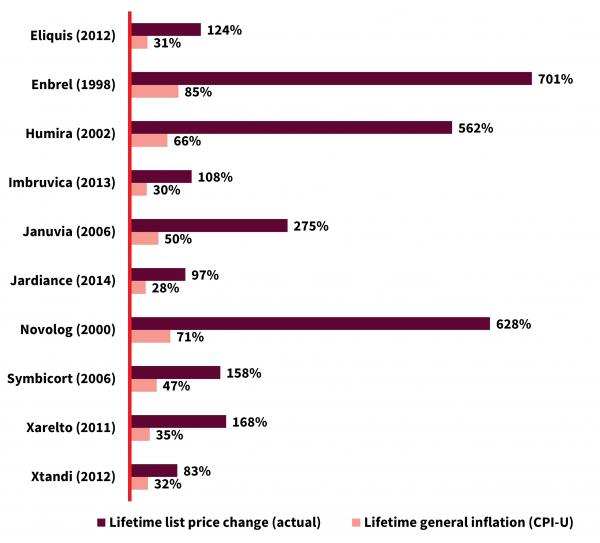New Report: Top Medicare Part D Drugs Have More Than Tripled in Price Since Entering Market
En español | WASHINGTON — List prices for the 25 brand-name drugs with the highest total Medicare Part D spending in 2021 have increased by an average of 226%—or more than tripled—since they first entered the market, a new report from AARP’s Public Policy Institute shows. For example, the price of Enbrel, used to treat rheumatoid arthritis and psoriatic arthritis, has increased by 701% since coming to market in 1998, and the price of Januvia, used to treat diabetes, has increased by 275% since entering the market in 2006. Overall, the lifetime price increases ranged from 20% to 739%, and all but one of the drugs’ lifetime price increases greatly exceeded the annual rate of inflation over the same period of time.
These 25 drugs were responsible for $80.9 billion in total Medicare Part D spending in 2021, about 37% of the total spending, and were used by more than 10 million Part D enrollees. The top medications include:
The report also found that, on average, nearly 60% of the current list price for the top 25 drugs is due to price increases after the product entered the market.
“Brand-name drug prices have increased dramatically faster than inflation for decades,” said Leigh Purvis, Prescription Drug Policy Principal, AARP Public Policy Institute, and author of the report. “The median price of a new brand-name prescription drug is now approximately $200,000 per year, so even relatively small percentage price increases can translate into thousands of dollars and put life-saving medications out of reach of the patients who need them.”
Congress recently passed the Inflation Reduction Act, a federal law requiring drug companies to pay a penalty to Medicare if their drug’s price increases faster than the rate of inflation. The law will also give Medicare the ability to negotiate lower drug prices with drug companies for the first time. The Centers for Medicare & Medicaid Services is expected to announce the first 10 drugs selected for negotiation by September 1, and the negotiated prices will become available in 2026.
“This historic law cracks down on the big drug companies and brings real relief to millions of seniors who have been struggling with out-of-control prescription drug prices,” said Nancy LeaMond, AARP Executive Vice President and Chief Advocacy and Engagement Officer. “American families simply can’t afford to keep paying the highest prices in the world for the medications they need.”
Over two-thirds (67%) of likely voters age 50 and older rate the cost of prescription drugs as a very important issue ahead of the 2024 elections, according to a recent AARP poll. The survey data shows that candidates, regardless of their party, could win votes by supporting policies that lower drug prices.
Methodology:
This report is based on an AARP Public Policy Institute analysis of 2021 data from the Centers for Medicare & Medicaid Services, Medicare Part D Spending by Drug Dashboard, and Medi-Span Price Rx Pro. Drug list price changes were compared to the corresponding rate of general inflation for the same period that each of the top 25 brand-name drugs has been on the market.
To view the full report, visit here.
# # #
About AARP
AARP is the nation's largest nonprofit, nonpartisan organization dedicated to empowering people 50 and older to choose how they live as they age. With a nationwide presence, AARP strengthens communities and advocates for what matters most to the more than 100 million Americans 50-plus and their families: health security, financial stability and personal fulfillment. AARP also produces the nation's largest circulation publications: AARP The Magazine and AARP Bulletin. To learn more, visit www.aarp.org/about-aarp/, www.aarp.org/español or follow @AARP, @AARPenEspañol and @AARPadvocates on social media.
































































